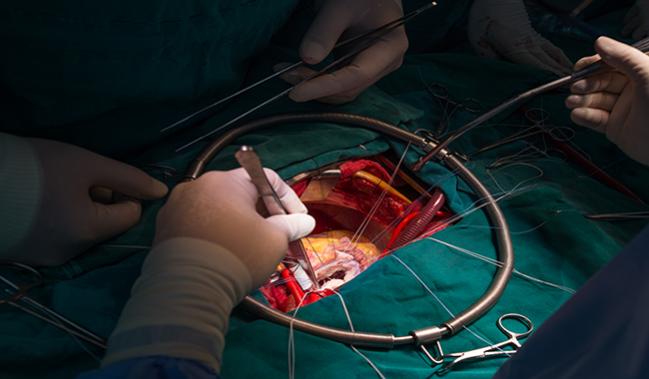High-Volume Surgeons More Likely to Perform Durable Mitral Valve Repairs, Have Better Outcomes
Referring physicians seeking good results should look not just at operators’ surgical volume but also at their mitral valve repair rates.

Patients treated by low-volume surgeons are more likely to have their mitral valve replaced rather than repaired, and the repairs that are performed are more likely to require a reoperation when compared with those done by higher-volume mitral operators, the results of a new study show.
More importantly, mortality at 1 year is significantly higher among patients undergoing mitral valve repair performed by a low-volume operator versus those treated by a higher-volume mitral operator.
“We all know that repair rates seems to be improved in surgeons seeing the mitral valve more often,” lead investigator Joanna Chikwe, MD (Icahn School of Medicine at Mount Sinai, New York, NY), told TCTMD. “We were able to show that durability of repair was actually about three times as good in patients operated on by surgeons doing more than 25 mitral valve operations per year. And that translates into even better survival at 1 year. More patients were likely to be alive at 1 year if they had their mitral valve repair done by a high-volume surgeon.”
The results were published May 2, 2017, in the Journal of the American College of Cardiology to coincide with the study’s presentation at the American Association for Thoracic Surgery meeting in Boston, MA.
Repair Over Replacement in Mitral Patients Needing Surgery
Mitral valve repair is a class I indication from the American College of Cardiology/American Heart Association (ACC/AHA) and European Society of Cardiology/European Association for Cardiothoracic Surgery (ESC/EACTS) for the treatment of patients with degenerative mitral regurgitation in need of surgery. Chikwe noted, however, that replacement is relatively common in patients with degenerative valve disease, with studies showing a wide variation in mitral valve surgical volume and repair rates.
In the present analysis, researchers identified 5,475 patients with degenerative mitral valve disease undergoing surgery between 2002 and 2013 in the New York Statewide Planning and Research Cooperative System (SPARCS) database. Of these patients, 66.8% had their valve repaired and 33.2% had their valve replaced. Repair rates for this indication at all 41 hospitals included in the analysis ranged from 25% to 100%.
Among the 5,475 patients, surgeons with an annual mitral valve surgery volume of less than 25 cases performed 25% of the surgeries. After adjusting for multiple variables—the patients treated by these low-volume operators were more likely to be urgent cases and have more comorbidities—surgical volume was independently associated with the repair rate. For example, the repair rate was 48.4% among surgeons performing 10 or fewer mitral operations annually compared with 77.2% for those who performed 51 or more cases each year.
Overall, each 10-case increment in annual mitral surgery volume increased the likelihood of repair over replacement by 13%.
Volume Alone Does Not Tell the Complete Story
To TCTMD, Chikwe said that volume is used as a surrogate for expertise, but it doesn’t tell the full story. “On its own, the number [of mitral valve surgeries] doesn’t necessarily predict that you’ll have a good repair,” she said. “I think what we’re really trying to encourage with referring physicians and patients is to look at not just the number of mitral valve operations in the surgeons, but what his or her repair rates actually are.”
The researchers also examined the association between mitral surgery volume and the risk of reoperation within 12 months of repair. For surgeons who performed more than 25 mitral valve operations per year, the risk of reoperation at 12 months following repair was 1.3% compared with 3.6% among cases by physicians with an annual volume of 25 or less mitral operations.
Overall, 1-year survival was significantly higher among patients treated by doctors performing more than 50 cases per year compared with those treated by physicians who performed 10 or fewer mitral valve repair or replacements annually (97.8% vs 94.1%; P < 0.001). In a risk-adjusted model that included mitral repair versus replacement, repair was associated with better survival, although annual higher surgical volume remained a predictor of mortality at 1 year.
The results “really speak to expertise and experience—it translates into more repairs, better repairs, and healthier patients,” said Chikwe.
Interestingly, having another high-volume mitral valve operator on staff appeared to influence repair rates, even among low-volume operators. For example, the repair rate was 64% among surgeons who performed fewer than 25 cases annually but who worked at a center with another surgeon who carried out more than 50 valve operations each year with a high repair rate. In contrast, the repair rate was 51.3% for low-volume operators without a higher-volume surgeon on staff. Chikwe called this a “halo” effect.
“It really speaks to the fact that mitral valve repair is a team occupation,” she said. “This is about clinical decision-making and intraoperative decision-making, where having an expert who can come in and look over a less experienced surgeon’s shoulder elevates their ability to perform complex surgery safely and well.”
Michael O’Riordan is the Managing Editor for TCTMD. He completed his undergraduate degrees at Queen’s University in Kingston, ON, and…
Read Full BioSources
Chikwe, J, Toyoda N, Anyanwu A, et al. Relation of mitral valve surgery volume to repair rate, durability, and survival. J Am Coll Cardiol. 2017;Epub ahead of print.
Disclosures
- Chikwe reports receiving speaking honoraria from Edwards Lifesciences.


Comments